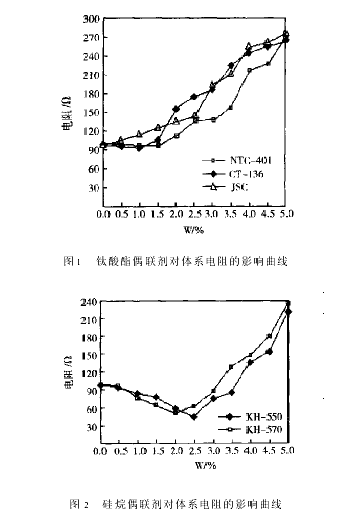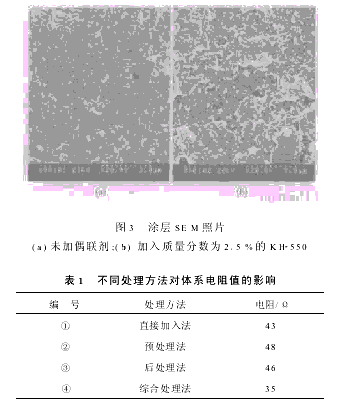Composite conductive coatings are generally based on ordinary insulating polymers as the main matrix (film-forming material), mixed with certain conductive fillers, ground and coated on the workpiece, and cured into a film at a certain temperature. The research and development of carbon black composite conductive coatings with low prices and oxidation resistance are increasingly being valued. The conductivity of conductive coatings is mainly related to factors such as the conductivity, content, particle size of fillers, and compatibility between polymers and filler particles. The finer the carbon black particles, the tighter the network chain stacking, and the larger the specific surface area; The more particles per unit mass, the more conducive it is to form a chain like conductive structure in the matrix. When other conditions are constant, the dispersion of carbon black particles in polymers will determine the conductivity of conductive coatings. When carbon black particles reach the nanoscale, their specific surface area is large, and they are prone to flocculation during the coating preparation process. Coupling agents can significantly affect the dispersion and wettability of fillers in the matrix [2]. Therefore, it is necessary to study the effects of different coupling agents on the conductivity of coatings. In addition, cracks are prone to occur during the film-forming process of carbon based composite conductive coatings, resulting in poor conductivity stability and affecting the application of the coatings. One effective treatment method is to add coupling agents. It can be seen that the application of coupling agents will directly determine the conductivity of carbon based composite conductive coatings. This experiment mainly studied the effects of three titanate coupling agents NTC401, CT136, JSC, and two silane coupling agents KH550 and KH570 on the conductivity of carbon black conductive coatings. It was found that different coupling agents and different addition methods of the same coupling agent have different effects on the conductivity.
1 Experimental section
1.1 Experimental equipment: High speed mixer: LJQ4 type, Tianjin Weida Testing Machine Factory; Ultrasonic oscillator: CX250 type, Beijing Medical Equipment Factory; Digital multimeter: BY1943 type, Shanghai Hengping Scientific Instrument Co., Ltd; Electronic balance: DT series, Jiangsu Changshu Changqing Instrument Factory; Electric constant temperature drying oven: DH72.1 type, Huangshi Medical Equipment Factory.
1.2 Experimental material: Highly conductive carbon black HGIP: average particle size 33nm, specific resistance value 0.52 Ω? Cm, Linzi Huaguang Chemical Factory, Zibo City; Alkyd varnish: Shijiazhuang Jinyu Paint Factory; Alkyd specific diluent: Shijiazhuang Jinyu Paint Factory; Titanate coupling agents: NTC401, CT136, JSC, Chiye Organic Silicon Materials (Shanghai) Co., Ltd; Silane coupling agents: KH550, KH570, Chiye Organic Silicon Materials (Shanghai) Co., Ltd.
1.3 Sample preparation
Wash the 75 × 25mm glass plate with acetone according to GB172779, dry it, and place it in a drying dish for later use. The mass fractions of coupling agents are 0%, 0.5%, 1%, 1.5%, 2%, 2.5%, 3%, 3.5%, 4%, 4.5%, and 5%, respectively, and the mass fractions of carbon black are all 15%. After treating the highly conductive carbon black with a coupling agent, add alkyd resin and diluent and disperse them using a high-speed mixer. Then, apply the brush coating method according to GB172779 to the glass plate. Make 3 parallel samples for each sample, cure at room temperature for 24 hours, cure at 60 ℃, and conduct surface resistance testing after the paint film is completely dry. Four methods were used to conduct experiments on the KH550 system with a mass fraction of 2.5%: ① Direct addition method, where the coupling agent and carbon black were directly added to the resin according to the above steps to prepare the sample; ② The pre-treatment method involves diluting the coupling agent with a specialized diluent, adding carbon black, oscillating in a magnetic oscillator for 60 minutes, filtering, and natural drying, followed by the above steps to prepare the sample; ③ Post processing method: Mix the coupling agent and alkyd resin evenly, place them in a magnetic oscillator for 60 minutes, add carbon black, and prepare the sample according to the above method; ④ The comprehensive processing method involves dividing the coupling agent used into two parts and treating the carbon black and alkyd resin according to methods ② and ③, respectively, and then preparing samples according to the above methods.
1.4 Performance testing uses a digital multimeter to measure the resistance value R of the sample, and SEM to observe the surface state of the coating.
2 Results and Discussion
2.1 The effect of coupling agents on conductivity: Coupling agents can improve the dispersion and wetting properties of fillers in the base material by coupling and bonding with inorganic filler surfaces through chemical reactions. It is necessary to choose appropriate coupling agents and their treatment methods based on different base material filler systems and the functions to be achieved. The carbon black alkyd conductive coating studied in this experiment has a resistance of 105 Ω without any coupling agent. Study the effect of five coupling agents on conductivity using a direct addition process.

Figure 1 shows the effects of three titanate coupling agents NTC401, CT136, and JSC on the conductivity of the system. As shown in Figure 1, after adding NTC401, CT136, and JSC, the resistance of the coating did not improve. On the contrary, with the increase of coupling agent dosage, the resistance value also increased from 104 Ω to 279 Ω. The coupling thickness of NTC401, CT136, and JSC on carbon black alkyd may be relatively large, hindering the mutual contact of carbon black particles and thus reducing conductivity. Therefore, NTC401, CT136, and JSC are not suitable for this system. The influence of silane coupling agents KH550 and KH570 on the conductivity of the system is shown in Figure 2. Within the range of 0-2.5% mass fraction of the coupling agent, both can appropriately reduce the resistance of the coating. For KH550, when the mass fraction is 25%, the coating resistance reaches the minimum value of 43 Ω; When the mass fraction of KH570 is 2.0%, the resistance is 54 Ω. Therefore, the more suitable coupling agent is KH550, with an optimal mass fraction of 2.5%. Without the addition of coupling agents, it is difficult for 33nm highly conductive carbon black to tightly bond with the resin, resulting in poor film-forming properties. Figure 3 shows the film-forming situation of the coating, and Figure 3 (a) is an SEM electron microscope photo of the system without coupling agents. As shown in the figure, the dispersion of carbon black particles is uneven, especially without a good interfacial transition layer between carbon black and resin; When KH550 with a mass fraction of 2.5% is added to the composite system, as shown in Figure 3 (b), the dispersion of carbon black particles is good. The coupling agent significantly improves the compatibility and chemical reactivity between carbon black and alkyd resin, endowing carbon black with good interfacial adhesion with the matrix. Moreover, the coupling thickness is appropriate, and the resistance of the coating is the lowest at this time.

2.2 The impact of different processing methods on conductivity depends on the structural characteristics, water resistance, actual objects and occasions of use of the coupling agent. Effective usage methods are necessary to fully achieve the effect of the coupling agent. There are two general methods for using coupling agents: pre-treatment method and direct addition method [2]. On this basis, post-treatment and comprehensive treatment methods were also considered in the experiment, and the mechanism of the coupling agent on the resin and filler was investigated. The experimental results obtained from processing KH550 using different methods are shown in Table 1. The results in Table 1 indicate that the coating resistance obtained by the pre-treatment method is the highest, followed by the post-treatment method. The coating resistance obtained by the direct addition method is lower, while the comprehensive treatment method is the lowest. According to the conductive mechanism of composite conductive coatings, only when a protective film with appropriate thickness is formed on the surface of conductive particles can the coupling agent play a dispersing and protective role, while also improving conductivity [3,4]. When the mass fraction of the coupling agent is constant, the pre-treatment method has the best coating effect due to its ability to avoid the influence of solvents and alkyd resins, but it affects the conductivity of the coating; The comprehensive treatment method has the best effect. In this case, the polar segment in the coupling agent has an adsorption effect on the surface of carbon black, including chemical adsorption and physical adsorption, allowing the coupling agent to coat the surface of carbon black particles, forming a certain thickness of barrier layer, reducing the attraction and cohesion between carbon black particles [5]; At the same time, the flexible segment of the coupling agent formed good compatibility with the matrix, and after mixing and dispersing the two, good dispersion stability was achieved. In the post-treatment method, after mixing the coupling agent with the alkyd resin solvent system for a long time (60 minutes), the coupling agent may have lost its coupling function, which is an unconventional treatment method and seems meaningless. However, the results show that the post-treatment method can still reduce the system resistance, indicating that the role of the coupling agent in conductive coatings is not only coupling and dispersion. For complex composite conductive coating systems, the selection or design of highly efficient coupling agents depends on a profound understanding of the mechanism of action of the coupling agent. The above research indicates that the effect of coupling agents may not only be limited to coupling and dispersion, but other effects still require further in-depth research. It can be seen that adding appropriate coupling agents can improve conductivity.
Conclusion (1) For different composite conductive coating systems, suitable coupling agents and optimal dosage can be selected through experiments. (2) In carbon black alkyd conductive coatings, the mass fraction of silane coupling agent KH550 is 2.5%. Carbon black and alkyd are treated with coupling agents and then added separately. The resulting system has good film-forming properties and the best conductivity.
 add wechat
add wechat

24 hours tle021-58997516

Mobi13321881626
Copyright © 2002-2022 ChiYe (shanghai) Co,ltd Address:Shanghai in China Case Number:沪ICP备14048717号-1 Siemap